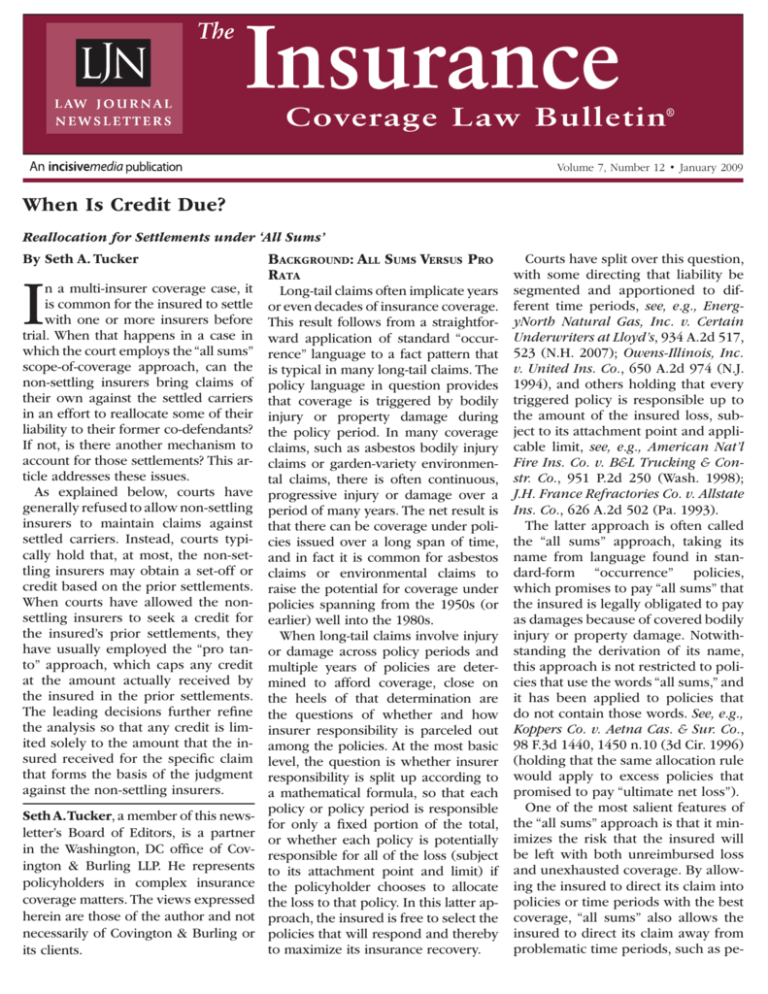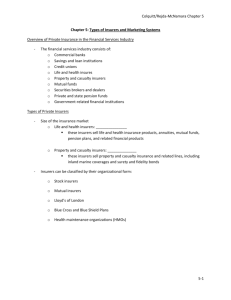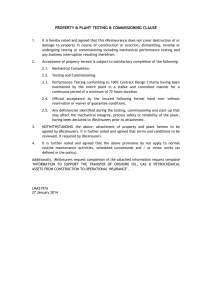
The
Insurance
Coverage Law Bulletin®
Volume 7, Number 12 • January 2009
When Is Credit Due?
Reallocation for Settlements under ‘All Sums’
By Seth A. Tucker
I
n a multi-insurer coverage case, it
is common for the insured to settle
with one or more insurers before
trial. When that happens in a case in
which the court employs the “all sums”
scope-of-coverage approach, can the
non-settling insurers bring claims of
their own against the settled carriers
in an effort to reallocate some of their
liability to their former co-defendants?
If not, is there another mechanism to
account for those settlements? This article addresses these issues.
As explained below, courts have
generally refused to allow non-settling
insurers to maintain claims against
settled carriers. Instead, courts typically hold that, at most, the non-settling insurers may obtain a set-off or
credit based on the prior settlements.
When courts have allowed the nonsettling insurers to seek a credit for
the insured’s prior settlements, they
have usually employed the “pro tanto” approach, which caps any credit
at the amount actually received by
the insured in the prior settlements.
The leading decisions further refine
the analysis so that any credit is limited solely to the amount that the insured received for the specific claim
that forms the basis of the judgment
against the non-settling insurers.
Seth A. Tucker, a member of this newsletter’s Board of Editors, is a partner
in the Washington, DC office of Covington & Burling LLP. He represents
policyholders in complex insurance
coverage matters. The views expressed
herein are those of the author and not
necessarily of Covington & Burling or
its clients.
Background: All Sums Versus Pro
Rata
Long-tail claims often implicate years
or even decades of insurance coverage.
This result follows from a straightforward application of standard “occurrence” language to a fact pattern that
is typical in many long-tail claims. The
policy language in question provides
that coverage is triggered by bodily
injury or property damage during
the policy period. In many coverage
claims, such as asbestos bodily injury
claims or garden-variety environmental claims, there is often continuous,
progressive injury or damage over a
period of many years. The net result is
that there can be coverage under policies issued over a long span of time,
and in fact it is common for asbestos
claims or environmental claims to
raise the potential for coverage under
policies spanning from the 1950s (or
earlier) well into the 1980s.
When long-tail claims involve injury
or damage across policy periods and
multiple years of policies are determined to afford coverage, close on
the heels of that determination are
the questions of whether and how
insurer responsibility is parceled out
among the policies. At the most basic
level, the question is whether insurer
responsibility is split up according to
a mathematical formula, so that each
policy or policy period is responsible
for only a fixed portion of the total,
or whether each policy is potentially
responsible for all of the loss (subject
to its attachment point and limit) if
the policyholder chooses to allocate
the loss to that policy. In this latter approach, the insured is free to select the
policies that will respond and thereby
to maximize its insurance recovery.
Courts have split over this question,
with some directing that liability be
segmented and apportioned to different time periods, see, e.g., EnergyNorth Natural Gas, Inc. v. Certain
Underwriters at Lloyd’s, 934 A.2d 517,
523 (N.H. 2007); Owens-Illinois, Inc.
v. United Ins. Co., 650 A.2d 974 (N.J.
1994), and others holding that every
triggered policy is responsible up to
the amount of the insured loss, subject to its attachment point and applicable limit, see, e.g., American Nat’l
Fire Ins. Co. v. B&L Trucking & Constr. Co., 951 P.2d 250 (Wash. 1998);
J.H. France Refractories Co. v. Allstate
Ins. Co., 626 A.2d 502 (Pa. 1993).
The latter approach is often called
the “all sums” approach, taking its
name from language found in standard-form “occurrence” policies,
which promises to pay “all sums” that
the insured is legally obligated to pay
as damages because of covered bodily
injury or property damage. Notwithstanding the derivation of its name,
this approach is not restricted to policies that use the words “all sums,” and
it has been applied to policies that
do not contain those words. See, e.g.,
Koppers Co. v. Aetna Cas. & Sur. Co.,
98 F.3d 1440, 1450 n.10 (3d Cir. 1996)
(holding that the same allocation rule
would apply to excess policies that
promised to pay “ultimate net loss”).
One of the most salient features of
the “all sums” approach is that it minimizes the risk that the insured will
be left with both unreimbursed loss
and unexhausted coverage. By allowing the insured to direct its claim into
policies or time periods with the best
coverage, “all sums” also allows the
insured to direct its claim away from
problematic time periods, such as pe-
LJN’s The Insurance Coverage Law Bulletin
riods with insolvent coverage, settled
coverage, or no applicable coverage.
An insured using the all sums approach has considerable flexibility in
allocating its losses in the first instance.
After that process has taken place,
courts typically allow the selected insurers to try to reallocate some or all
of the loss to other triggered insurers.
Thus, for example, if the insured has
“spiked” its losses into a single year
and has reached through the primary
and umbrella policies and into excess
layers, the insurers that paid the loss
in the first instance may try to reallocate to lower-lying or co-equal coverage in other years.
Insurers pursue these reallocations
using a variety of theories or mechanisms, including their “other insurance” clauses, notions of contribution,
or the concept of subrogation. Regardless of the doctrine or policy provision
invoked, if this attempt is successful it
allows the selected insurer to reduce,
in whole or part, the amount by which
it is out of pocket by forcing one or
more other insurers to pay for some
of the loss.
But what happens if the insured has
settled with some of the other insurers? Can the non-settling insurers that
are called upon to pay pursue claims
for reimbursement against the settled
carriers? And if not, how, if at all, are
the settled policies accounted for?
Courts Typically Bar
Reimbursement Claims Against
Settled Insurers
Courts from around the country
have rejected attempts by non-settling insurers to reallocate their “all
sums” liability to their settled brethren. These courts recognize that the
strong public policy in favor of settlements would be undermined if settled
insurers could find themselves back
in litigation for the same claims they
thought they had settled.
Insurers, and indeed litigants generally, usually settle for at least two
reasons: for certainty and for peace.
See, e.g., Weyerhaeuser Co. v. Commercial Union Ins. Co., 15 P.3d 115,
126 (Wash. 2000) (“the insurers that
January 2009
chose to settle in this case … purchased certainty by avoiding the risks
of an adverse trial outcome — not to
mention forgoing the expenses associated with a lengthy trial and appeal”). That is, by settling they avoid
the risk of an outcome that is worse
than the settlement, and they save the
expense and disruption associated
with litigation.
If a settled insurer could be sued
on the settled claim by a non-settling
insurer, it would be deprived of both
of these benefits. Specifically, it could
face added exposure, which would
deprive it of the benefit of having
fixed its loss at a sum certain, and the
added litigation would force it to incur
the expense and distraction of litigation. (These effects may be mitigated
by agreements by the insured to indemnify and/or defend the settled insurer in the event of such claims, but
policyholders often refuse to provide
such agreements, and a policyholder
that had to indemnify or defend a settled insurer would itself be deprived
of much of the benefit of settling.)
Moreover, if settled insurers were
subject to reallocation claims by nonsettling carriers, not only would they
lose the benefits of settling, but they
could find themselves worse off than
if they had refused to settle in the
first place. This is so because upon
settling, they play no further role in
the main coverage case and leave it
to the other insurers to build and litigate any possible coverage defenses.
Whether or not they would technically be bound by the coverage determinations, they might feel at a disadvantage if the court had already made
those determinations once. Some defendants might be comfortable allowing other similarly situated parties to
develop and try their defenses, but
many would prefer to play a substantial role in that process if they will be
called upon to pay the judgment.
Because permitting non-settling insurers to chase settled insurers would
deprive the latter of the benefits of
settlement, it would undermine the
public policy in favor of settlements
by discouraging insurers from set-
tling. Not surprisingly, court after
court has refused to permit reallocation claims against settled insurers.
See, e.g., Puget Sound Energy v. Certain Underwriters at Lloyd’s, London,
138 P.3d 1068 (Wash. App. 2006), review denied, No. 79165-1, 2007 Wash.
LEXIS 531 (Wash., July 11, 2007); Koppers Co. v. Aetna Cas. & Sur. Co., 98
F.3d 1440, 1453 (3d Cir. 1996); NCR
Corp. v. AIG Centennial Ins. Co., Case
No. 05-CV-2101 (Wis. Cir. Ct. Brown
Cty. Apr. 24, 2008); Bondex Int’l, Inc.
v. Hartford Acc. & Indem. Co., Case
No. 1:03-CV-01322, 2007 WL 405938
at *4 (N.D. Ohio Feb. 1, 2007); In
re Asbestos Ins. Coverage Cases, No.
1072, Statement of Decision Concerning Phase IV Issues (Calif. Super. Ct.,
San Francisco County Jan. 24, 1990),
aff’d in part and rev’d in part on
other grounds sub nom. Armstrong
World Indus. v. Aetna Cas. & Sur. Co.,
35 Cal. App. 4th 192 (1993), vacated
and remanded on other grounds, 904
P.2d 370 (Cal. 1995).
These and other courts have concluded that once an insurer has settled with its policyholder, it should
be free from continued or follow-on
litigation by the policyholder’s other
insurers.
Settlement Credits/Set-Offs: Pro
Rata Versus Pro Tanto
Although they are usually barred
from attempting to reallocate their
“all sums” liability to settled insurers,
non-settling insurers that face such liability typically ask the court to allow
set-offs or credits based on the settled
policies. The non-settling insurers
typically advance two rationales. The
first is a so-called “fairness” rationale.
Insurers making this argument note
that but for the settlements with the
now-dismissed insurers, the non-settling insurers would have been able
to spread the liability among more
parties, thereby reducing their share
of the overall exposure. They contend
that it is unfair to allow the insured
to deprive them of the benefit of the
insured’s other insurance.
The second rationale is that policyholders should not be able to recover
LJN’s The Insurance Coverage Law Bulletin
more in insurance than they incurred
in liability, and thus set-offs are necessary based on recoveries from settled insurers to prevent a windfall to
the policyholder.
Courts have by and large been
receptive to set-offs or settlement
credits in concept, but because most
courts have correctly focused on the
“no double recovery” rationale, in
practice set-offs have often proven
elusive.
Just as the allocation world divides
between “pro rata” and “all sums,”
so too the settlement credit world
divides between “pro rata” and “pro
tanto.” A pro rata credit is one that
is determined not by reference to
what the policyholder actually received from the settled insurers, but
by reference to what the settled policies would have paid had there been
no settlement.
The leading “pro rata” credit case
is the Third Circuit’s decision in Koppers. In that case, the court predicted
that the Pennsylvania Supreme Court
would give non-settling insurers credit based upon the settled insurers’
“apportioned shares.” See Koppers,
98 F.3d at 1453. The Third Circuit did
not specify how those shares were to
be determined.
The “pro rata” credit approach largely undermines the “all sums” rule in
at least two ways. First, it returns to
the world of pro rated shares of liability among triggered policies. The “all
sums” rule is supposed to allow the
insured to avoid those sorts of fights
about the division of responsibility
among insurers.
Second, the “pro rata” credit approach undermines a core tenet of
“all sums” allocation, namely, that the
policyholder should be fully covered
for the loss so long as there is triggered insurance available to pay. As
the Indiana Superior Court reasoned
in Eli Lilly v. Aetna Cas. & Sur. Co.,
No. 49D12 0102 CP 000243 (Ind.
Super. Ct. July 15, 2002), an insured
that settles with some of its carriers
during litigation usually has to take
less than the full share of those in-
January 2009
surers’ policies’ potential liability on
the claim in order to induce the carrier to settle. To require the insured to
take on the responsibility for the gap
between the settlement amount and
the full allocated share of liability for
the settled policies — as that liability
would have been determined once all
of the trial court’s decision had been
made — would usually leave the insured undercompensated, despite
the availability of triggered insurance
from the non-settling carriers. Accord
Cascade Corp. v. American Home
Assurance Co., 135 P.3d 450, 455-56
(Ore. Ct. App. 2006) (rejecting an allocation share set-off because a settlement credit should not allow an insurer that has agreed to pay up to its
policy limits to pay less, “leaving the
insured with a loss for which there is
no coverage”).
Not only does the “pro rata” credit
undermine the “all sums” allocation
regime, but it also lacks a coherent
theoretical basis that is consistent
with “all sums.” It is worth noting, for
example, that in arriving at its “apportioned share” rule, the Third Circuit in
Koppers relied principally on a Pennsylvania Superior Court decision that
pre-dated the Pennsylvania Supreme
Court’s ruling, in the J.H. France case,
that “all sums” was the law of Pennsylvania. See Koppers, 98 F.3d at 1453
(discussing Gould, Inc. v. Cont’l Cas.
Co., 585 A.2d 16 (Pa. Super. Ct. 1991)).
It is hard, if not impossible, to square
the “apportioned share” rule with the
“all sums” rule.
The “pro rata” credit approach suffers from another deficiency: It fails
to promote settlement. Specifically, it
requires an insured to bear the uncertainty of how the court handling the
litigation will ultimately apportion liability. In so doing, it provides a powerful disincentive for the insured to
compromise. See, e.g., Cascade, 135
P.3d at 458. At the same time, by holding out the prospect of a substantial
diminution of their exposure if they
litigate the case to conclusion, the pro
rata credit approach rewards insurers
for resistance. See, e.g., Eli Lilly, No.
49D12 0102 CP 000243, slip op. at 4.
As noted above, there is another
approach to settlement credits called
the “pro tanto” approach. Under this
approach, the non-settling insurers
receive at most a credit in the amount
that the policyholder actually obtained from the settled carriers for
the claim that is in litigation. This is
the majority rule. See, e.g., Ins. Co. of
N. Am. v. Kayser-Roth Corp., 770 A.2d
403 (R.I. 2001); Weyerhaeuser Co. v.
Commercial Union Ins. Co., 15 P.3d
115 (Wash. 2000); Liberty Mut. Ins.
Co. v. Black & Decker Corp., 383 F.
Supp. 2d 200, 216-17 (D. Mass. 2004);
Goodrich Corp. v. Commercial Union
Ins. Co., C.A. Nos. 23585 & 23586,
2008 Ohio App. LEXIS 2716 (Ohio Ct.
App. June 30, 2008); Cascade Corp.,
135 P.3d at 454; Massachusetts Elec.
Co. v. Commercial Union Ins. Co., No.
99-00467B, 2005 Mass. Super. LEXIS
548, at *6-7 (Mass. Super. Ct. Oct. 25,
2005); Eli Lilly, No. 49D12 0102 CP
000243.
Under this approach, if the insured
would otherwise receive a double recovery, the insured’s judgment against
non-settlers may be reduced dollar
for dollar up to the actual amount received in prior settlements pertaining
to the same claim. Unlike in the “pro
rata” approach, the recovery from the
non-settling insurers is not reduced
by some arbitrarily calculated percentage share that exceeds the actual
settlement recoveries.
The “pro tanto” approach allows a
court to protect against double recovery by the insured, while still promoting the full recovery that is the
essence of “all sums” allocation. See,
e.g., Mass. Elec. Co., 2005 Mass. Super. LEXIS 548, at *6 (holding that
the pro tanto credit is consistent with
“all sums”).
Calculating Settlement Credits/
Set-Offs
There is one potential complication
that can arise when one uses the “pro
tanto” approach, and that is determining the amount of a given settlement
that is to be allocated to the claim for
LJN’s Entertainment Law & Finance
which the non-settling insurers have
been adjudged liable. If the policyholder’s settlements with its other insurers were as narrow as the claim in
litigation, it may be easy to determine
the amount that the insured received
for that particular claim. However,
frequently the insured and the settled
insurers have resolved more than simply the narrow matter in litigation. As
the Washington Supreme Court recognized in Weyerhaeuser:
[T]he insurers that chose to settle
in this case received far more than
a simple release of liability at specific sites. Rather these companies also purchased certainty by
avoiding the risks of an adverse
trial outcome — not to mention
forgoing the expenses associated
with a lengthy trial and appeal. As
the insurers “paid Weyerhaeuser
for a release from an unquantifiable basket of risks and considerations,” we cannot say the settlements simply constituted payment
for Weyerhaeuser’s cleanup costs.
Weyerhaeuser, 15 P.3d at 126 (citations omitted).
When the policyholder’s prior settlements provide no clear allocation
to particular claims, there is typically
no clear answer to the question of
how much the insured received for
the narrow claim that the non-settling
insurers have been adjudged liable
to pay.
When this complication arises,
courts frequently place on the nonsettling insurers the burden of proving the amount that the insured recovered on the particular claim. For
example, as the Washington Supreme
Court put it, “if a non-settling insurer
seeks to offset its responsibility for
a claim using proceeds from such a
settlement, it has the burden of establishing what part of the settlement
was attributable to the claim it seeks
to offset.” Puget Sound Energy, Inc.
v. ALBA Gen. Ins. Co., 68 P.3d 1061,
1064 (Wash. 2003). That court noted
in an earlier decision that placing the
burden of proof on the policyholder
would “encourage litigation and re-
January 2009
ward the nonsettling insurer for refusing to settle.” Weyerhaeuser, 15
P.3d at 126.
Courts are often quite scrupulous
in applying this burden of proof. For
example, in the Puget Sound Energy
case, the insured’s past costs had totaled approximately $14 million. See
Phase I Findings Of Fact And Conclusions Of Law, Puget Sound Energy, Inc. v. Certain Underwriters at
Lloyd’s, London, No. 01-2-30326-1 SEA
(Wash. Super. Ct. King County June 2,
2003), slip op. at 10. The remaining
defendant, the London Market Insurers, sought an offset based on settlements totaling almost $20 million. Id.
However, the trial court held that the
insured had not been made whole
because, in return for the settlement
dollars, it had released not only the
specific settled claims for past costs,
but also, among other things, unknown amounts with respect to future costs, unknown amounts with
respect to claims for bad faith, and
various other claims. Id. at 10-11. This
precluded a finding that the insured
had been made whole.
Similarly, in the recent decision in
Goodrich, the Ohio appellate court
affirmed the trial court’s refusal to
provide a settlement credit to the two
non-settling insurers based on Goodrich’s recoveries from other insurers.
The appeals court held that because
a set-off or settlement credit is essentially an affirmative defense, the
burden of proof rests with the insurer
seeking such a set-off, and that the insurer’s burden was to prove that without a set-off, the policyholder would
receive a double recovery. See Id. at
**21-22.
In that case the non-settling insurers argued that because Goodrich
had received more than $58 million
in settlements and its liability after
trial was $42 million, the trial court
should have subtracted the settlement
recovery from the damages amount
and zeroed out its liability. See Id. at
**23. However, because Goodrich’s
prior settlements had not been strictly limited to the environmental prop-
erty damage that was at issue in the
lawsuit, but had included releases for
bodily injury, for example, the trial
court and the court of appeals agreed
with Goodrich that the non-settling
insurers could not prove that Goodrich would receive a double recovery if those non-settling insurers were
forced to make good on the judgment
against them. See Id. at **23-25.
In employing the “pro tanto”
credit approach and in holding the
non-settling insurers to their burden of proving double recovery before any credit is actually applied,
these courts advance the primary
goal of “all sums” allocation, which
is to afford the insured the full benefit of its bargain. This approach
to settlement credits is the one that
is most consistent with “all sums”
allocation.
Reprinted with permission from the January 2009 edition of the Law
Journal Newsletters. © 2009 Incisive US Properties, LLC. All
rights reserved. Further duplication without permission is prohibited. For
information, contact 877.257.3382 or reprintscustomerservice@incisivemedia.com. Visit www.incisivemedia.com #055081-01-09-003







